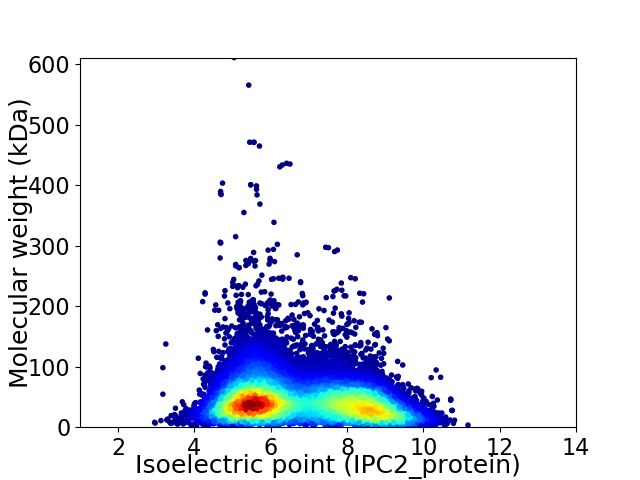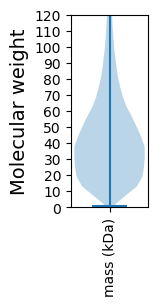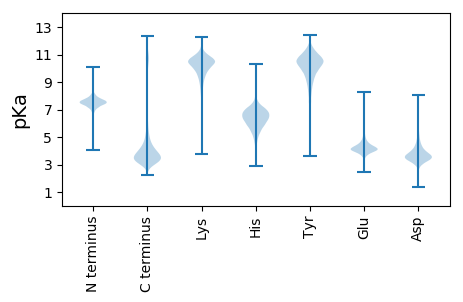
Arabidopsis thaliana (Mouse-ear cress)
Taxonomy: cellular organisms; Eukaryota; Viridiplantae; Streptophyta; Streptophytina; Embryophyta; Tracheophyta; Euphyllophyta; Spermatophyta; Magnoliopsida; Mesangiospermae; eudicotyledons; Gunneridae; Pentapetalae; rosids; malvids; Brassicales; Brassicaceae; Camelineae; Arabidopsis
Average proteome isoelectric point is 6.73
Get precalculated fractions of proteins

Virtual 2D-PAGE plot for 41612 proteins (isoelectric point calculated using IPC2_protein)
Get csv file with sequences according to given criteria:
* You can choose from 21 different methods for calculating isoelectric point
Summary statistics related to proteome-wise predictions



Protein with the lowest isoelectric point:
>tr|F4I456|F4I456_ARATH Tetratricopeptide repeat (TPR)-like superfamily protein OS=Arabidopsis thaliana OX=3702 GN=TPR2 PE=1 SV=1
MM1 pKa = 7.53LNIIINVMEE10 pKa = 5.03IIWRR14 pKa = 11.84TIVSTLMLFFFLRR27 pKa = 11.84YY28 pKa = 9.41FNNPLLLFFFLCTILFLLIIDD49 pKa = 4.5RR50 pKa = 11.84NRR52 pKa = 11.84SVYY55 pKa = 10.72EE56 pKa = 3.85EE57 pKa = 4.07TGDD60 pKa = 4.05FYY62 pKa = 11.94VLYY65 pKa = 9.88TFQEE69 pKa = 4.43DD70 pKa = 3.36NMLDD74 pKa = 3.71GEE76 pKa = 4.83IIDD79 pKa = 5.17KK80 pKa = 10.78NRR82 pKa = 11.84EE83 pKa = 3.94CCDD86 pKa = 3.33FTRR89 pKa = 11.84YY90 pKa = 10.44YY91 pKa = 11.18YY92 pKa = 10.38DD93 pKa = 4.07DD94 pKa = 4.16CFSYY98 pKa = 11.48YY99 pKa = 10.78DD100 pKa = 4.29GFDD103 pKa = 3.26EE104 pKa = 5.18VDD106 pKa = 3.31NDD108 pKa = 3.86GCIWNDD114 pKa = 3.8DD115 pKa = 3.95EE116 pKa = 6.99DD117 pKa = 5.6FSQCNQDD124 pKa = 3.85GGDD127 pKa = 3.89DD128 pKa = 4.43GIEE131 pKa = 4.42NRR133 pKa = 11.84DD134 pKa = 3.54DD135 pKa = 4.86DD136 pKa = 5.69DD137 pKa = 3.66NHH139 pKa = 7.87AYY141 pKa = 10.41GDD143 pKa = 4.23DD144 pKa = 3.79VDD146 pKa = 6.17DD147 pKa = 4.54DD148 pKa = 4.44TLTSRR153 pKa = 11.84IEE155 pKa = 4.12DD156 pKa = 3.93YY157 pKa = 10.72IANVYY162 pKa = 9.72NGWRR166 pKa = 11.84EE167 pKa = 3.68EE168 pKa = 3.87RR169 pKa = 11.84RR170 pKa = 11.84TDD172 pKa = 3.4KK173 pKa = 11.35LFVV176 pKa = 3.43
MM1 pKa = 7.53LNIIINVMEE10 pKa = 5.03IIWRR14 pKa = 11.84TIVSTLMLFFFLRR27 pKa = 11.84YY28 pKa = 9.41FNNPLLLFFFLCTILFLLIIDD49 pKa = 4.5RR50 pKa = 11.84NRR52 pKa = 11.84SVYY55 pKa = 10.72EE56 pKa = 3.85EE57 pKa = 4.07TGDD60 pKa = 4.05FYY62 pKa = 11.94VLYY65 pKa = 9.88TFQEE69 pKa = 4.43DD70 pKa = 3.36NMLDD74 pKa = 3.71GEE76 pKa = 4.83IIDD79 pKa = 5.17KK80 pKa = 10.78NRR82 pKa = 11.84EE83 pKa = 3.94CCDD86 pKa = 3.33FTRR89 pKa = 11.84YY90 pKa = 10.44YY91 pKa = 11.18YY92 pKa = 10.38DD93 pKa = 4.07DD94 pKa = 4.16CFSYY98 pKa = 11.48YY99 pKa = 10.78DD100 pKa = 4.29GFDD103 pKa = 3.26EE104 pKa = 5.18VDD106 pKa = 3.31NDD108 pKa = 3.86GCIWNDD114 pKa = 3.8DD115 pKa = 3.95EE116 pKa = 6.99DD117 pKa = 5.6FSQCNQDD124 pKa = 3.85GGDD127 pKa = 3.89DD128 pKa = 4.43GIEE131 pKa = 4.42NRR133 pKa = 11.84DD134 pKa = 3.54DD135 pKa = 4.86DD136 pKa = 5.69DD137 pKa = 3.66NHH139 pKa = 7.87AYY141 pKa = 10.41GDD143 pKa = 4.23DD144 pKa = 3.79VDD146 pKa = 6.17DD147 pKa = 4.54DD148 pKa = 4.44TLTSRR153 pKa = 11.84IEE155 pKa = 4.12DD156 pKa = 3.93YY157 pKa = 10.72IANVYY162 pKa = 9.72NGWRR166 pKa = 11.84EE167 pKa = 3.68EE168 pKa = 3.87RR169 pKa = 11.84RR170 pKa = 11.84TDD172 pKa = 3.4KK173 pKa = 11.35LFVV176 pKa = 3.43
Molecular weight: 21.15 kDa
Isoelectric point according different methods:
Protein with the highest isoelectric point:
>sp|P93014|RR5_ARATH 30S ribosomal protein S5 chloroplastic OS=Arabidopsis thaliana OX=3702 GN=rps5 PE=2 SV=1
MM1 pKa = 7.1RR2 pKa = 11.84AKK4 pKa = 9.27WKK6 pKa = 9.53KK7 pKa = 9.88KK8 pKa = 8.64RR9 pKa = 11.84MRR11 pKa = 11.84RR12 pKa = 11.84LKK14 pKa = 10.08RR15 pKa = 11.84KK16 pKa = 8.21RR17 pKa = 11.84RR18 pKa = 11.84KK19 pKa = 8.46MRR21 pKa = 11.84QRR23 pKa = 11.84SKK25 pKa = 11.41
MM1 pKa = 7.1RR2 pKa = 11.84AKK4 pKa = 9.27WKK6 pKa = 9.53KK7 pKa = 9.88KK8 pKa = 8.64RR9 pKa = 11.84MRR11 pKa = 11.84RR12 pKa = 11.84LKK14 pKa = 10.08RR15 pKa = 11.84KK16 pKa = 8.21RR17 pKa = 11.84RR18 pKa = 11.84KK19 pKa = 8.46MRR21 pKa = 11.84QRR23 pKa = 11.84SKK25 pKa = 11.41
Molecular weight: 3.43 kDa
Isoelectric point according different methods:
Peptides (in silico digests for buttom-up proteomics)
Below you can find in silico digests of the whole proteome with Trypsin, Chymotrypsin, Trypsin+LysC, LysN, ArgC proteases suitable for different mass spec machines.| Try ESI |
 |
|---|
| ChTry ESI |
 |
|---|
| ArgC ESI |
 |
|---|
| LysN ESI |
 |
|---|
| TryLysC ESI |
 |
|---|
| Try MALDI |
 |
|---|
| ChTry MALDI |
 |
|---|
| ArgC MALDI |
 |
|---|
| LysN MALDI |
 |
|---|
| TryLysC MALDI |
 |
|---|
| Try LTQ |
 |
|---|
| ChTry LTQ |
 |
|---|
| ArgC LTQ |
 |
|---|
| LysN LTQ |
 |
|---|
| TryLysC LTQ |
 |
|---|
| Try MSlow |
 |
|---|
| ChTry MSlow |
 |
|---|
| ArgC MSlow |
 |
|---|
| LysN MSlow |
 |
|---|
| TryLysC MSlow |
 |
|---|
| Try MShigh |
 |
|---|
| ChTry MShigh |
 |
|---|
| ArgC MShigh |
 |
|---|
| LysN MShigh |
 |
|---|
| TryLysC MShigh |
 |
|---|
General Statistics
Number of major isoforms |
Number of additional isoforms |
Number of all proteins |
Number of amino acids |
Min. Seq. Length |
Max. Seq. Length |
Avg. Seq. Length |
Avg. Mol. Weight |
|---|---|---|---|---|---|---|---|
17599415 |
5 |
5400 |
422.9 |
47.32 |
Amino acid frequency
Ala |
Cys |
Asp |
Glu |
Phe |
Gly |
His |
Ile |
Lys |
Leu |
|---|---|---|---|---|---|---|---|---|---|
6.272 ± 0.011 | 1.847 ± 0.006 |
5.405 ± 0.009 | 6.757 ± 0.016 |
4.259 ± 0.008 | 6.354 ± 0.013 |
2.279 ± 0.005 | 5.327 ± 0.01 |
6.367 ± 0.012 | 9.593 ± 0.016 |
Met |
Asn |
Gln |
Pro |
Arg |
Ser |
Thr |
Val |
Trp |
Tyr |
|---|---|---|---|---|---|---|---|---|---|
2.442 ± 0.004 | 4.396 ± 0.007 |
4.784 ± 0.014 | 3.551 ± 0.008 |
5.385 ± 0.009 | 9.194 ± 0.013 |
5.08 ± 0.008 | 6.644 ± 0.008 |
1.235 ± 0.004 | 2.828 ± 0.008 |
Most of the basic statistics you can see at this page can be downloaded from this CSV file
Proteome-pI is available under Creative Commons Attribution-NoDerivs license, for more details see here
| Reference: Kozlowski LP. Proteome-pI 2.0: Proteome Isoelectric Point Database Update. Nucleic Acids Res. 2021, doi: 10.1093/nar/gkab944 | Contact: Lukasz P. Kozlowski |
